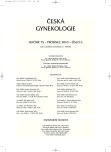Operation procedures in female sterilisation
Authors:
A. Kořenek
Authors‘ workplace:
Gynekologicko-porodnické oddělení, Jesenická nemocnice, s. r. o., přednosta MUDr. A. Kořenek, Ph. D.
Published in:
Ceska Gynekol 2010; 75(6): 518-520
Overview
Objective:
Review of operation procedures in female sterilisation.
Design:
Review article.
Setting:
Gynecological-Obstetrical Department, Jesenik Hospital.
Conclusion:
Female sterilisation can be done through laparotomy, minilaparotomy, colpotomy, laparoscopy and also through the transcervical approach, which has long been thought to be the optimal method for permanent female sterilization, with tubal access achieved by blind, direct (hysteroscopic) or indirect (radiological) techniques, and occlusion being achieved by chemical, mechanical, or thermal techniques. Tubal occlusion is protect factor for recurrent pelvic inflammatory disease and ovarian cancer. After uneventful pregnancy course and delivery, it does not seem justified to delay the endoscopic sterilization to a later time. Hysteroscopic sterilisation can be performed successfully with a IUD in place. The proportion of major complications was higher in group postpartum sterilisation by minilaparotomy than in interval laparoscopic sterilization unrelated to pregnancy.
Key words:
female sterilisation, hysteroscopy, laparotomy.
Sources
1. Abbott, J. Transcervical sterilization. Curr Opin Obstet Gynecol, 2007, 19, 4, p. 325-330.
2. Ameh, N., Madugu, NH., Bawa, US., et al. Tubal ectopic pregnancy after bilateral tubal ligation: A case report. Niger J Med, 2006, 15, 4, p .453-454.
3. Bigolin, S., Fagundes, DJ., Rivoire, HC., et al. Transcervical hysteroscopic sterilization using cyanoacrylate: a long-term experimental study on sheep. J Obstet Gynaecol Res, 2009, 35, 6, p. 1012-1018.
4. Huber, AW., Mueller, MD., Ghezzi, F., et al. Tubal sterilization: complications of laparoscopy and minilaparotomy. Eur J Obstet Gynecol Reprod Biol, 2007, 134, 1, p. 105-109.
5. Jensen, JT., Rodriguez, MI., Liechtenstein-Zábrák, J., et al. Transcervical polidocanol as a nonsurgical method of female sterilization: a pilot study. Contraception, 2004, 70, p. 111-113.
6. Kjaerbye-Thygesen, A., Frederiksen, K., HŅgdall, EV., et al. Do risk factors for epithelial ovarian cancer have an impact on prognosis? Focus on previous pelvic surgery and reproductive variables. Eur J Gynaecol Oncol, 2006, 27, 5, p. 467-472.
7. Kobilková, J., Živný, J., Bochman, J. Technika gynekologických abdominálních operací. Praha: Grada 2000, s. 94-97.
8. Kuscu, E., Duran, HE., Zeyneloglu, HB., et al. The effect of surgical sterilization on ovarian function: a rat model. Eur J Obstet Gynecol Reprod Biol, 2002, 10, 2, p. 204-207.
9. Levgur, M., Duvivier, R. Pelvic inflammatory disease after tubal sterilization: a review. Obstet Gynecol Surv, 2000, 55, 1, p. 41-50.
10. Macků, F., et al. Kompendium gynekologických operací. Praha: Grada, 1995, s. 153-155.
11. Palter, SF., Al-Rejjal, R., Berky, C. The Endosquid, a new device for laparoscopic Pomeroy tubal ligation. J Am Assoc Gynecol Laparosc, 2001, 8, 3, p.433-437.
12. Spörri, S., Bell, B., Yandell, R. Diode laser assisted transcervical tubal sterilization: an in vivo study in rabbits. Lasers Surg Med, 2001, 29, 4, p. 379-385.
13. Tan, BL., Chong, C., Tay, EH., et al. Migrating Filshie clip. Aust N Z J Obstet Gynaecol, 2004, 44, 6, p. 583-584.
14. Tatalovich, JM., Anderson, TL., et al. Hysteroscopic sterilization in patients with a Mirena intrauterine device: transition from extended interval to permanent contraception. J Minim Invasive Gynecol, 2010, 17, 2, p. 228-231.
Labels
Paediatric gynaecology Gynaecology and obstetrics Reproduction medicineArticle was published in
Czech Gynaecology

2010 Issue 6
Most read in this issue
- Vulvodynia and the possibility of its management
- Operation procedures in female sterilisation
- Asherman’s syndrome II – therapy, methods of guidance, prevention of readhesion processs, complications and results of therapy
- Nalbuphine at maternal analgesia
